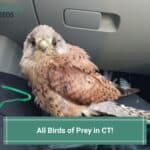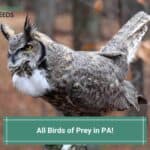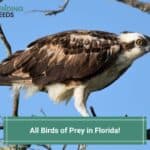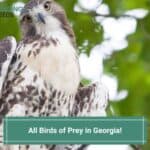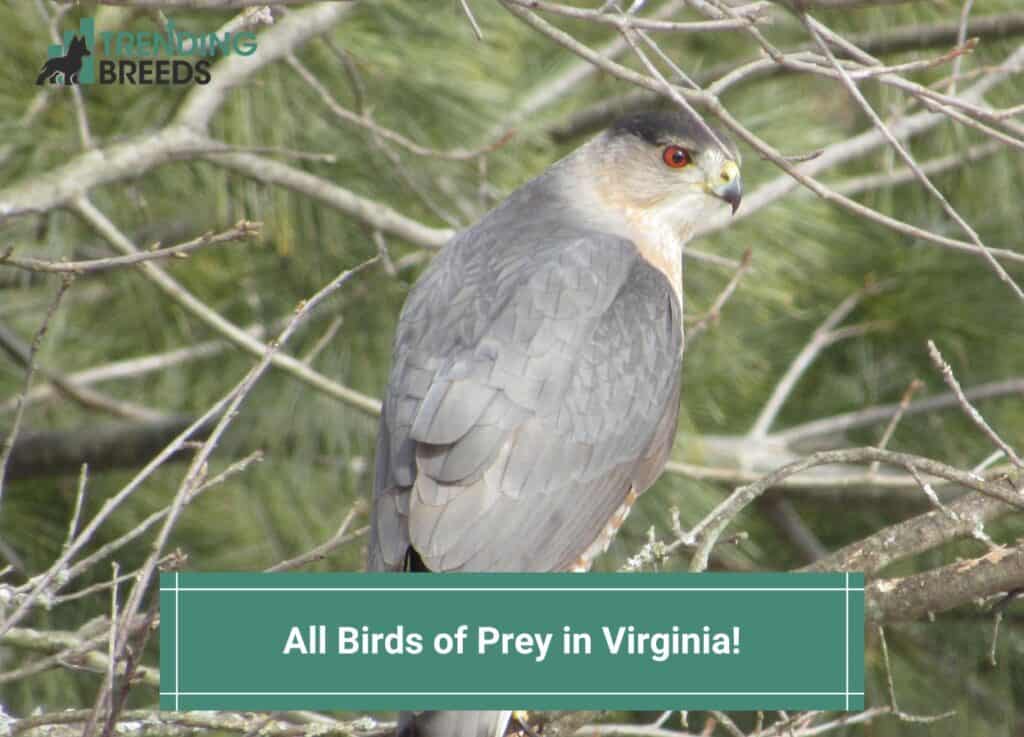
Have you ever seen a bird of prey soaring through the skies? Its sharp eyes scanning the landscape with unwavering focus? Naturally, birds of prey in Virginia have an extensive profile.
In this article, we will discuss several raptors that you can witness in the region.
Get to know everything you need to about the iconic bald eagle to the agile Peregrine falcon.
Understanding and appreciating these birds is essential. Not only are they beautiful, but they are critical for maintaining the delicate balance of our ecosystems.
These predators play a crucial role in controlling populations of prey. Additionally, they also act as indicators of environmental health.
Learn more about their awe-inspiring creatures, unique characteristics, hunting strategies, and habitats.
Before you scroll further down this guide, check out these other animal-related articles: Best Cavapoo Breeders In Virginia and Best Schnoodle Breeders in Virginia.
Table of Contents
1. Red-Tailed Hawk
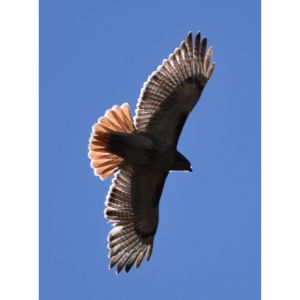
Red-Tailed Hawk Characteristics:
- Scientific Name: Buteo jamaicensis
- Length: 17.7 and 25.6 inches
- Weight: 24.3 to 51.5 ounces
- Wingspan: 44.9 to 52.4 inches
- Conservation Status: Least Concern
The red-tailed hawks are magnificent birds found in most American states. You can see them soaring through lush forests and suburban skylines.
They may range in color from white to black, so there is no one color by which you can identify them; however, their characteristic red tail is a dead giveaway.
The red-tailed hawks are very adaptable. They do not have a preference for a particular habitat, and they can make nests anywhere they feel comfortable.
Red-tailed hawks are adept hunters, and they usually hunt in pairs. The two hawks guard each side and tag-team when targeting their prey.
Their diet usually includes small animals such as birds, reptiles, or mammals.
The northern red-tailed hawk migrates far toward the south. Most adults migrate at the central or southern latitudes.
These raptors usually migrate late fall or early spring season. The red-tailed hawk has a shrill raspy scream.
2. Sharp-Shinned Hawk
Sharp-Shinned Hawk Characteristics:
- Scientific Name: Accipiter striatus
- Length: 9-13.5 inches
- Weight: 3-8 ounces
- Wingspan: 16.5-26.5 inches
- Conservation Status: Least Concern
The sharp-shinned hawk is one of the smallest raptors in America. It is also a purely migratory bird that moves south or north with the changing season.
The sharp-shinned hawk’s blue-gray wings and orange-patterned chest feathers make it easily recognizable. This raptor has a petite body but a long tail.
Sharp-shinned hawks prefer to live and nest in forests.
When these raptors migrate, they usually look for open habitats or high places like tall trees. In contrast, they are found in woods or bushy areas during winter.
The sharp-shinned hawk mainly feeds on small songbirds. These birds may be as small as a sparrow or sometimes the size of a quail.
Occasionally, they may prey on lizards, snakes, bats, and insects.
Sharp-shinned hawks have a distinct high pitch shrill sound. You may hear their ‘kik-kik-kik’ in the Virginian forests if you listen closely.
Although their conservation status is ‘Least Concern,’ recently, their population has declined in the area.
3. Barn Owl

Barn Owl Characteristics:
- Scientific Name: Tyto alba
- Length: 12 – 15 inches
- Weight: 16 – 20 ounces
- Wingspan: 42 – 43 inches
- Conservation Status: Least Concern
The barn owl has a ghost-like appearance and a rasping shriek. It is one of the most widespread birds of prey, easily found on six continents.
This raptor feeds at night and rarely during the daytime. It finds its target by watching and listening intently in open fields. They have excellent night vision and hearing.
The barn owl has the skill to target its prey even in low light levels. These birds primarily feed on rodents such as mice, rats, and shrews.
Occasionally, it may feed on rabbits, insects, frogs, or fish. Their usual habitats include woodlands, groves, barns, cliffs, etc.
A few regions have seen a decline in their population, but overall the population of barn owls is thriving.
Contrary to typical perception, they do not hoot. They sound like red-tailed hawks.
4. Northern Saw-Whet Owl
Northern Saw-Whet Owl Characteristics:
- Scientific Name: Aegolius acadicus
- Length: 6.5–9 inches
- Weight: 1.9-5.3 ounces
- Wingspan: 16.5–22.2 inches
- Conservation Status: Least Concern
The saw-whet owl is one of the tiniest owls with a cat-like face, big head, and yellow eyes.
As the name states, the northern saw-whet owl is commonly found in the northern parts of North America.
However, it is found throughout the US in winter as it migrates toward warmer regions.
Since it is a nocturnal bird, it is rarely seen by humans. Their diet usually consists of small rodents such as mice, voles, etc.
Sometimes they may even hunt small birds or large insects. During the breeding season, the male sings continuously during the night.
This sound helps mark territory and attract females. Their habitat usually consists of forests, groves, or confers.
The owl makes a sound that resembles the sharpening of a saw. It may sound like a ‘Too-too-too’ that is emitted at a frequency of two notes per second.
Recently, there has been a population decline in Virginia, but still, they are widespread and relatively common.
5. Broad-Winged Hawk
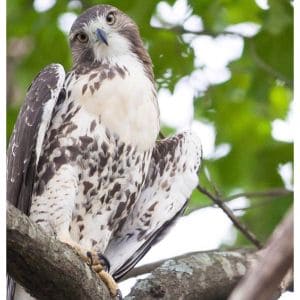
Broad-winged Hawk Characteristics:
- Scientific Name: Buteo platypterus
- Length: 13.5-17.5 inches
- Weight: 16 ounces
- Wingspan: 33 inches
- Conservation Status: Least Concern
Broad-winged hawks have short and stocky bodies, so they can perfectly adapt to life in the forest.
They are not readily observable because they prefer to spend time in deep woods away from humans.
These hawks are most famous for their fantastic display when they migrate every fall.
On average, these hawks travel a total of 4000 miles one way. They complete this trip biannually.
Broad-winged hawks usually eat small mammals, reptiles, birds, and amphibians. Sometimes they may even eat crayfish, centipedes, and earthworms.
The best way to find them in the thick forest is to listen to their whistling call. Previously, a large number of these birds were shot during migration.
But now, with regulations in place, the population is healthy and thriving.
6. Rough-Legged Hawk
Rough-Legged Hawk Characteristics:
- Scientific Name: Buteo lagopus
- Length: 18.5-23.5 inches
- Weight: 25-49 ounces
- Wingspan: 52-54 inches
- Conservation Status: Least Concern
The rough-legged hawk is also called the rough-legged buzzard or rough-legged falcon. It is native to the Arctic tundra.
These hawks are only visible in Virginia during the winters after they migrate to the south.
Their unusual characteristic includes having feathers on their feet, which is uncommon for hawks. These feather help to keep them warm in colder areas.
Their usual habitat includes tundra and arctic coasts during their breeding season. They spend their winter in grasslands, farmlands, and dunes.
Rough-legged hawks mostly eat lemmings and voles. Lemmings comprise more than 80% of their diet in summer.
These chunky large birds of prey in Virginia have a unique hunting style. They hover, looking for food, facing the wind simultaneously.
Mostly these raptors do not make any sound, except they may make a mewing sound near their nest.
7. Black Vulture
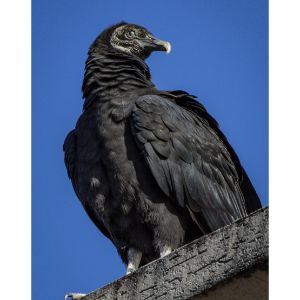
Black Vulture Characteristics:
- Scientific Name: Coragyps atratus
- Length: 22-29 inches inches
- Weight: 3½-6½ pounds
- Wingspan: 51-66 inches
- Conservation Status: Least Concern
Black vultures get their name because of the black feathers that cover their entire body.
They have a hairless, short, and compact head with black skin. However, you may observe silver feathers on their wings on the underside whenever they fly.
They also form the letter ‘V’ because they fly with raised wings.
They can be found in forests and open areas and forage for food in the country. Primarily observed in flocks, they may drive turkey vultures away from food.
Black vultures mainly feed on the dead carcasses of animals. They may even eat the eggs of other birds, sea turtles, and sometimes newborn mammals.
Vultures are silent most of the time but may occasionally grunt or hiss. Adult black vultures remain in their breeding territories for the entire year.
Due to the unavailability of suitable nesting sites, their population is decreasing in a few regions of the southeast.
8. American Bald Eagle
American Bald Eagle Characteristics:
- Scientific Name: Haliaeetus leucocephalus
- Length: 28-40 inches
- Weight: 6.5-15 lbs
- Wingspan: 71-97 inches
- Conservation Status: Least Concern
The American bald eagle is an easily recognizable bird in Virginia because of its bright white head.
But this characteristic feature only appears once they are five years old. Their most common habitat includes bodies of water such as marshes, lakes, and rivers.
They exhibit opportunistic feeding behavior; sometimes, they behave as a predator and sometimes as a scavenger.
Mainly they feed on fish such as catfish, salmon, and herring. They may feed on other birds or small mammals when they can’t find fish.
They usually nest on trees near water bodies where they can easily hunt for food. Adult birds from southern and coastal adults are permanent residents and do not migrate to other regions.
Their population decreased due to an increase in pesticides. However, their population has steadily increased after the ban on these chemicals.
9. Golden Eagle

Golden Eagle Characteristics:
- Scientific Name: Aquila chrysaetos
- Length: 27.6-33.1 inches
- Weight: 6.4-13.2 ounces
- Wingspan: 72-86 inches
- Conservation Status: Least Concern
The golden eagle is an awe-inspiring raptor that migrates to Virginia during spring or fall.
They are different from American bald eagles because they do not have white heads. It is also one of the fastest and largest raptors in North America.
Birdwatchers will most likely observe this magnificent creature soaring high in the skies. They usually hunt small mammals such as rabbits.
Occasionally they may even feed on other game birds as large as the crane. Some of these golden eagles also hunt young deer or foxes.
Their usual habitat includes open terrain and country, foothills, and mountains. In summer, they restrict themselves to their nesting sites.
The population of golden eagles has dropped significantly in Virginia over the years. The main reason includes rapid urbanization and poisoned prey.
10. Osprey
Osprey Characteristics:
- Scientific Name: Pandion haliaetus
- Length: 20-25.5 inches
- Weight: 3-4.4 pounds
- Wingspan: 59-71 inches
- Conservation Status: Least Concern
Ospreys are neither hawks nor eagles and have a separate category. They look like hawks, often called Sea Hawk or River Hawk.
They are easier to identify since they have a white belly and chest. In contrast, their upperparts are gray with black wrist patches on their lower wings.
Ospreys are the only raptor species to dive into the water to catch fish. Their diet consists primarily of fish, and their habitats are close to large bodies of water.
In Virginia, ospreys are found from April through later September.
They make a sound that consists of short and high-pitched whistles. People often compare their sounds to that of a teapot.
11. American Kestrel
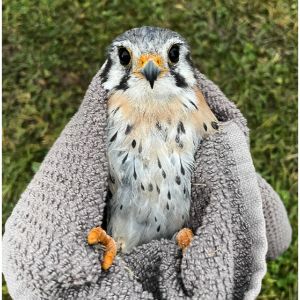
American Kestrel Characteristics:
- Scientific Name: Falco sparverius
- Length: 9-12 inches
- Weight: 2.8-5.8 ounces
- Wingspan: 20-24 inches
- Conservation Status: Least Concern
The American kestrel is one of Virginia’s smallest raptors and almost the same size as a robin or a sparrow.
However, its small stature does not make it any less of a hunter.
The other name for this bird is sparrow hawk, probably because it can hunt down sparrows in the blink of an eye.
American kestrels are the most commonly found raptors in Virginia. Their hunting style is to hover at a low height, looking for their prey.
The American kestrel primarily eats worms and insects. It may hunt mice, bats, and lizards occasionally.
Their habitats usually include country sites, farmland, and wood edges. Kestrels also have a distinct call that sounds like ‘Klee-Klee-Klee’ on repeat.
The population of these tiny raptors is decreasing in northeast areas. However, nesting boxes are helping to give a boost to their habitats.
12. Peregrine Falcon
Peregrine Falcon Characteristics:
- Scientific Name: Falco peregrinu
- Length: 13-23 inches
- Weight: 12-53 ounces
- Wingspan: 29-47 inches
- Conservation Status: Least Concern
The Peregrine falcon is one of the fastest birds on Earth, considering it can dive at a speed of more than 200 mph.
Adult Peregrine falcons have blue-gray wings and dark brown backs. Their underside has brown spots and black tear stripes on their face.
This bird of prey mainly feeds on other birds. Almost 145 species of birds are included in their list of targets.
Their habitats include open country, cliffs, and occasionally cities. They are permanent residents of the Northwest Coast.
The Peregrine falcons do not make much sound. However, they have a call similar to an alarm clock, like ‘Kack-Kack-Kack.’
Species of these raptors almost disappeared in 1940-1970 due to the excessive use of DDT.
However, these species have been reintroduced in some of the temperate areas of North America.
13. Turkey Vulture
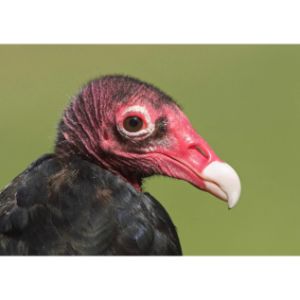
Turkey Vulture Characteristics:
- Scientific Name: Cathartes aura
- Length: 25-32 inches
- Weight: 2-5 pounds
- Wingspan: 63-72 inches
- Conservation Status: Least Concern
The turkey vulture or turkey buzzard is common among birds of prey in Virginia. It is found throughout the US.
Turkey vultures are easy to identify since they have black feathers and a bald red head. They resemble a turkey, hence the name.
The turkey vultures have a highly advanced sense of smell and can smell dead carcasses from 8 miles away.
They are also seen soaring in the skies in the open countryside. Their habitats are widespread throughout the county but most commonly within rocky or wooded areas.
Like other species of vultures, these also make hissing and grunting sounds.
Frequently Asked Questions
How rare is it to see a golden eagle?
It can be pretty difficult to spot a golden eagle in Virginia.
How close can you get to an osprey nest?
Most bird experts recommend no closer than 500 feet.
What is a bird that looks like a bald eagle?
Turkey vultures can look very similar to a bald eagle when they are in flight.
All Birds of Prey in Virginia
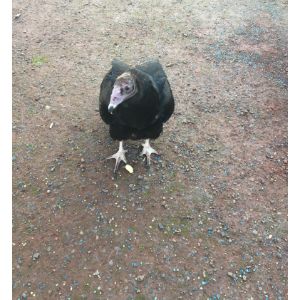
The birds of prey that grace the skies of Virginia exemplify nature’s beauty and the intricate balance of the ecosystem.
From their striking physical features to their extraordinary hunting abilities, these birds are a testament to the wonders of the natural world.
By cherishing and safeguarding their habitats, we must ensure that future generations will also have the privilege of witnessing the awe-inspiring presence of these majestic birds in Virginia.
If you find this guide, “All Birds of Prey in Virginia,” informative and helpful, you can check out these other bird-related articles from our team:
You can learn more about birds by watching “How to choose your First Bird of Prey” down below:

